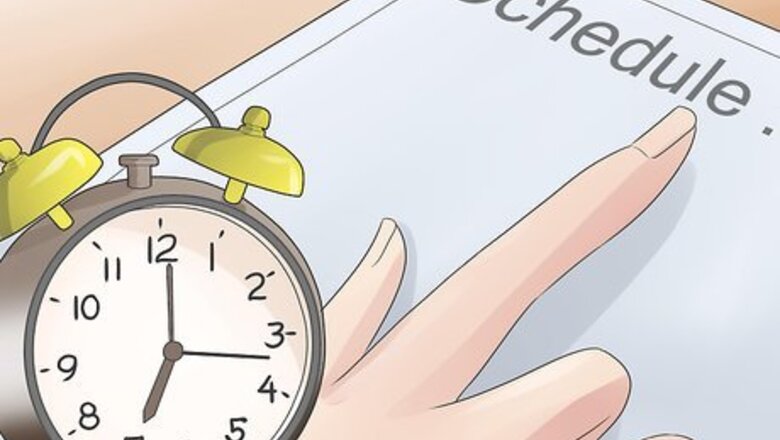
views
Making Time for Exercise
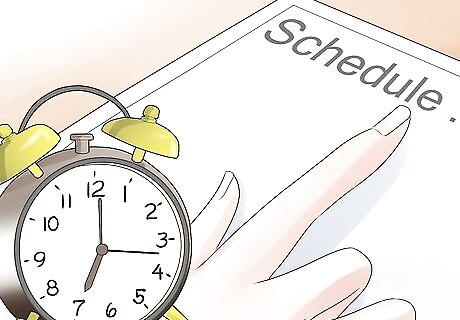
Write out your daily schedule. Sometimes it can be difficult to think of a time to exercise. You may think back on your day and wonder when in the world could you fit in a trip to the gym or even just a few minutes of exercise. Writing out your schedule can help. Sit down and write out a very detailed timeline and schedule of your typical workday. Start with when you get up, how long it takes you to get ready, what time you leave for work, etc. The more detailed you are, the easier it will be to find time in your day. Once you have your schedule and timeline written out, search for a time that would be good to schedule in a workout or a trip to the gym. Also consider if you could rearrange things in your schedule to make more room for a workout. In addition, find some back up times. If you run work late at work on Monday, where can you fit in a workout on Tuesday? You may not find room for a workout every day or enough time to fit in an entire trip to the gym. That's OK. Even 10-15 minutes is enough time to fit in a short exercise session.
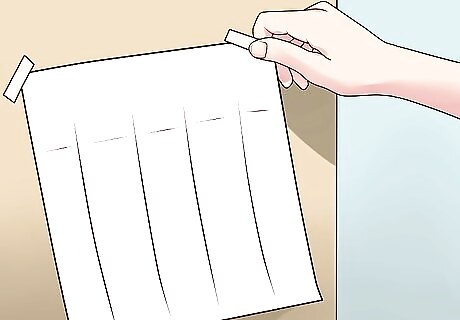
List your favorite workouts. After looking at your daily schedule and working on your calendar you may realize you'll need to different types of workouts on different days depending on how much time you have. Have a list of different types of activities of varying lengths. This will give you much more flexibility in your schedule to fit in a workout. If you have at least an hour or so, this is a great chance to hit the gym and do a combination of cardio and strength training. You'll have plenty of time to do adequate amounts of each. If you have only 30-45 minutes, choose to do either cardio or strength training. You could try to squeeze in both, but you may have an easier time just doing one or the other. If you just have 15-20 minutes, try an ultra fast workout. There are many available online, on workout DVDs or in magazines. They usually combine both cardio and strength training so that it elevates your heart rate rapidly.
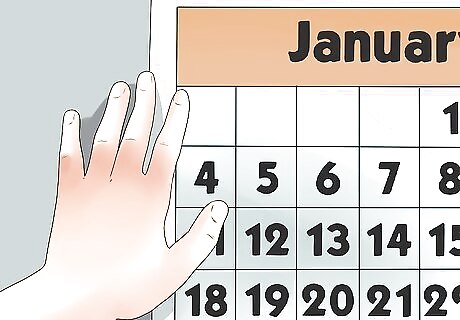
Create a workout calendar. Once you know what time of day or between which activities you can fit in a gym session, start creating a workout calendar. Schedule in your exercise for the entire week on your calendar. You can even schedule in an entire month if you feel that'd be helpful. This will help you keep you on track of what time you're going to exercise, where and what type. Also, scheduling in your exercise in a planner or calendar like a doctors appointment or important meeting can help you stick to your plan.
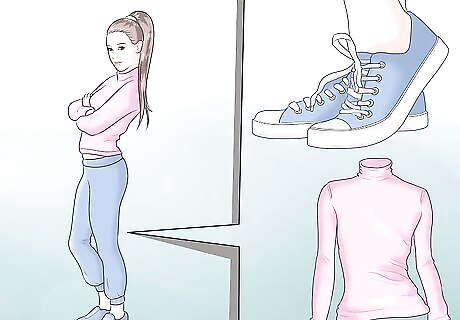
Pack your gym bag in advance. Being prepared and ready to exercise can help weed out some excuses of why you can't fit in the time to be active. Sometimes it's difficult to go home after a long day, change for the gym, and then go back out. Change into your gym clothes at the office or bring your pre-packed bag with you right to the gym after work. If you prefer to hit the gym in the morning or exercise in the morning, bring your work clothes and toiletries with you to the gym so you can leave right to work. In addition to getting your gym bag packed in advance, you could lay your workout clothes for an early morning exercise session or even wear your workout clothes to sleep. EXPERT TIP Monica Morris Monica Morris ACE Certified Personal Trainer Monica Morris is an ACE (American Council on Exercise) Certified Personal Trainer based in the San Francisco Bay Area. With over 15 years of fitness training experience, Monica started her own physical training practice and gained her ACE Certification in 2017. Her workouts emphasize proper warm-ups, cool-downs, and stretching techniques. Monica Morris Monica Morris ACE Certified Personal Trainer Expert Trick: Think about any equipment or additional items you'll want during your workout. When you're packing a gym bag, make sure to include any accessories you'll need, including gloves, wraps for your hands, a weight belt, and a timer. However, it's a good idea to leave your phone at home. It will just get in your way.

Go for even 10 minutes of activity. You may not be able to do your ideal gym workout everyday. Even though each day may not be perfect, getting in even a few minutes of activity is better than none. Many definitions of exercise, especially cardio, says that you need to do the activity for at least 10 minutes. If that's all you, then you're meeting those minimum guidelines. The USDA suggests getting in 150 minutes of exercise each week. If you just did a 10-minute walk or short work out 3 times a day, 5 days a week, you'd meet that goal.
Finding the Right Type of Exercise
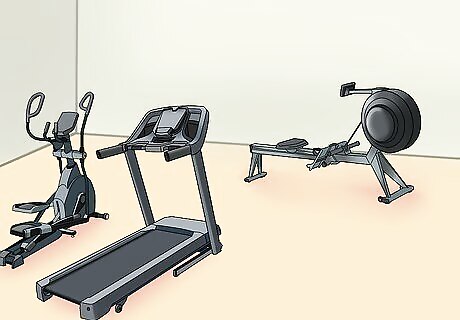
Sample different cardio machines. When you go to gyms these days, you'll notice that many have a large variety of cardio equipment. Find the right type of machine for you and one that you enjoy. Since cardio exercises will most likely make up a large part of your exercise during the week (that 150 minutes each week), you'll want to make sure that you find an activity that you enjoy. Try out each of the cardio machines at the gym. If you're not sure how to use some of them, ask a personal trainer or gym staff member to help you. If you don't enjoy doing cardio inside the gym, see if there is something you can do outside. Running, jogging and biking are all activities that may be more enjoyable for you outside of the gym.
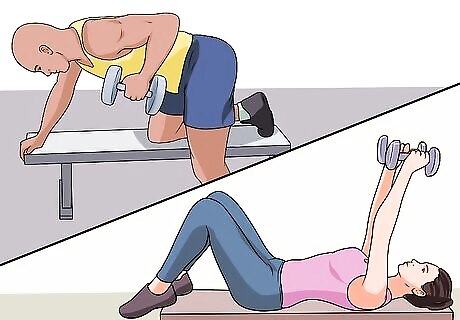
Try a gym group class. One way to get you into the gym and more excited about your workout is trying out a few group classes. These are fun and enjoyable ways to get moving. Group classes may be more enticing to you and more motivating for you to get to the gym due to the group aspect of it. You may meet friends and get to enjoy your 7 pm class every week. It's fun to hit the gym hard with friends in a group. Many gyms offer a wide variety of classes that are geared to many fitness levels. Try out a few that you think would be fun. Try: aerobic dance classes, water aerobics, weight lifting classes, yoga, pilates or even kickboxing.
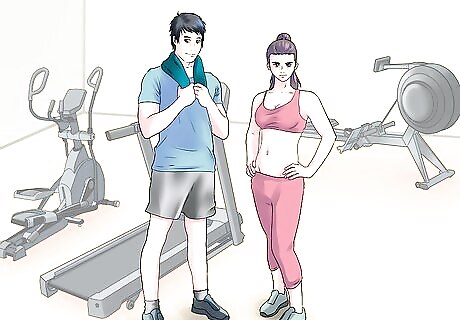
Work out with a friend. Studies have shown that one way to stay motivated and get to the gym is working out with a friend. Ask friends, family members or coworkers to go to the gym with you. This will be especially helpful if you need to exercise early in the morning or later in the evening. Having someone to "feel the pain" with you is nice. It might also be helpful and motivating to start a little friendly competition. If you're a competitive person, this might keep you on schedule.

Do a combination of activities each week. One of the reasons people give up on working out or begin to skip the gym is because they get bored of their routine. Prevent this by changing it up. Getting on the treadmill each day for 45 minutes might get old after a while. Even doing the same weight lifting routine can get boring. Switch up the activities you do throughout the week to prevent you from getting burnt out. In addition to changing the type of exercise you do, consider alternating between some outside activities and some gym exercise. Some days you may enjoy a nice walk outside, while other days you may want to spend more time lifting weights at the gym. Also include more fun and non-traditional activities for exercise. A bike ride through the city, a hiking trip or kayaking tour are all fun and innovative ways to get in some physical activity.
Staying Motivated
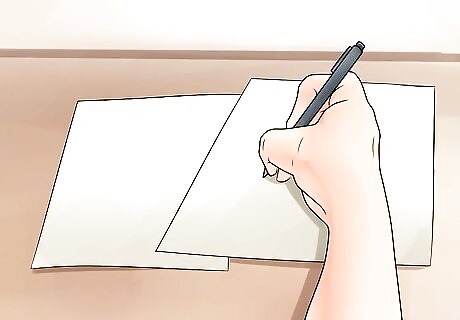
Write out the benefits of exercise. Sometimes even no matter how much time or how prepared you are to hit the gym, you're just not in the mood. Give yourself an extra boost by writing out some reasons why exercise is beneficial. Both cardio and strength training activities offer you a wide range of benefits. Some include: decreased risk of osteoporosis, increased metabolism and increased ability to burn calories, decreased risk for diabetes and high blood pressure, improved sleep, improved mood, and increased energy. Exercise may also make you feel proud of yourself, happy, content, energized and "on track" with any healthy eating plans you may be following. Write out some of these benefits as they apply to you. When you're not feeling up to working out, try reviewing some of these benefits a few times in your head. You might just get the little extra bump in motivation you need. EXPERT TIP Laila Ajani Laila Ajani Fitness Trainer Laila Ajani is a Fitness Trainer and founder of Push Personal Fitness, a personal training organization based in the San Francisco Bay Area. With over 10 years as a trainer and exercise specialist, Laila has expertise in competitive athletics (gymnastics, powerlifting, and tennis), personal training, distance running, and Olympic lifting. Laila is certified by the National Strength & Conditioning Association (NSCA), USA Powerlifting (USAPL), and she is a Corrective Exercise Specialist (CES). Laila Ajani Laila Ajani Fitness Trainer It's okay if you don't feel motivated every day, but it's crucial to establish a sense of discipline. A consistent workout routine is the key to achieving fitness goals. It is essential to remain determined and committed to your plan. Select a suitable time of day that fits your schedule. Dedicate around 30 to 60 minutes to exercise, and stick with it.
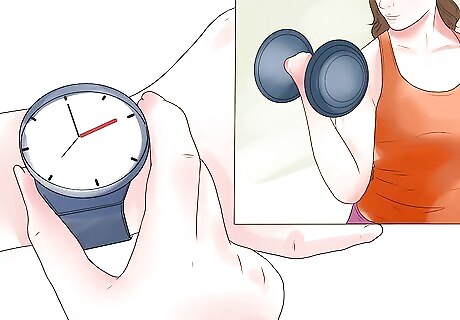
Visualize yourself working out. Some studies have shown that if you spend some time visualizing yourself working out, the more likely you are to actually follow through with your work out. If you workout in the morning, take 5 or 10 minutes at night to visualize yourself working out. See yourself getting up with your alarm, getting dressed and going to the gym. Follow a similar pattern even if you workout in the afternoon. Also visualize and imagine how you feel after a workout. Concentrate on those positive feelings.
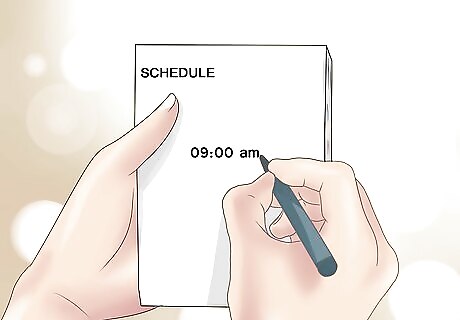
Plan for days off. Rest days are an important part of your physical activity routine. In addition, life might get in the way and force you to have a day off. Plan for these in your mind so they don't stress you out. Everyone goes through busy seasons at work, meetings that run late or bad traffic on your commute to the gym. That's fine. If you missed your work out or didn't have the time, take the day off. Get back to your regular schedule as soon as you can. Think of "missed days" as your day off or recovery time from exercise. These rest days are important to your recovery and the repair of your body and muscles after a few days of exercise.
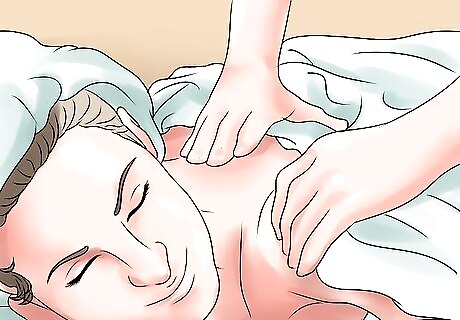
Reward yourself. Nothing is more motivating than a reward. Set up some enticing rewards to help you stay motivated and on track with your exercise plan. Decide what you need to do in order to earn a reward. Maybe it's going to the gym 3-4 times a week for an entire month, doing 150 minutes of cardio each week or running 15 miles a week. Schedule in a reward once you meet that goal. It might be purchasing a few new workout songs, getting a new workout shirt or even something more luxurious like a massage. If you're trying to lose weight or stick to a healthy eating plan, you may want to avoid rewarding yourself with dinners out or other food related activities.










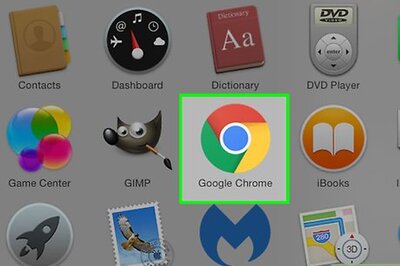








Comments
0 comment